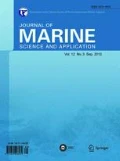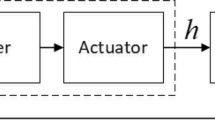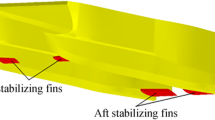Abstract
This paper discusses mathematical modeling of a ship equipped with energy-saving wing devices. Therewith, the ship is mathematically represented by an elongated hull with high-aspect-ratio wings mounted near its bow and stern. Equations, describing ship motions in regular oncoming waves, are written in the spirit of strip theory with account of inertial and damping influence of energy-saving wing elements with the use of linear expansion of wing-related forces with respect to heave and pitch perturbations. This approach readily yields fast numerical solutions for the propulsion of a ship with wings in waves. The latter solutions are then used as an input for calculation of thrust on wing elements on the basis of classical unsteady foil theories corrected for finite aspect ratio. To evaluate speed of the ship in the modes which allow cruising exclusively by wave power, it is hypothetically assumed that in this case, the wave-generated thrust on the wings equals total drag of the ship-plus-wings system, the latter being defined as a sum of its viscous, wave-making, induced (for wing elements) and added-wave components. Excepting the added-wave term and wings’ contributions, the total drag is calculated herein by Holtrop method whereas added-wave resistance is evaluated with Beukelman-Gerritsma formula involving kinematic parameters of heaving and pitching motions of the ship calculated both without and with account of the wings. Also discussed in the paper is a decrease of added wave resistance for a ship with wings as compared to that of ship without wings. Finally, the energy efficiency design index (EEDI) introduced by the International Maritime Organization (IMO) is discussed for representative sea conditions as a measure of ship environmental friendliness.


































Similar content being viewed by others
Change history
11 October 2021
A Correction to this paper has been published: https://doi.org/10.1007/s11804-021-00229-8
References
Alexandersson M (2009) A study of methods to predict added resistance in waves. Master thesis. KTH Center of Naval Architecture, Stockholm, pp 1–65
Angvik I (2009) Application of an active foil propeller on an offshore vessel. M.Sc. thesis. Norwegian University of Science and Technology, Norway
Aung HP (2020) Computer-aided design and optimization of propulsion systems with medium-speed engines: Ph.D thesis. –Saint-Petersburg, SMTU (in Russian)
Avis JS (1989) Reducing added resistance using an anti-pitching foil. University of British Columbia. Master of Applied Science, Vancouver, Canada
Belibassakis KA, Filippas E (2015) Ship propulsion in waves by actively controlled flapping foils. Appl Ocean Res 52:1–11. https://doi.org/10.1016/j.apor.2015.04.009
Belibassakis KA, Politis GK (2013) Hydrodynamic performance of flapping wings for augmenting ship propulsion in waves. Ocean Eng 72:227–240. https://doi.org/10.1016/j.oceaneng.2013.06.028
Blagoveshchenskii SN, Kholodilin AN (1975) Handbook of ship statics and dynamics. Ed. 2nd, reprint and additional Volume 2. Dynamics (motion) of the ship. Leningrad Shipbuilding Institute, 1–176 (in Russian)
Bøckmann E (2015) Wave propulsion of ships. Doctoral thesis. Norwegian University of Science and Technology, Norway
Bøckmann E, Steen S (2016) Calculation of EEDIweather for a general cargo vessel. Ocean Eng 122:68–73. https://doi.org/10.1016/j.oceaneng.2016.06.007
Borgen CT (2010) Application of an active foil propeller. M.Sc. thesis. Norwegian University of Science and Technology, Norway
Bowker JA, Townsend NC, Tan M and Shenoi RA (2016) Experimental analysis of submerged flapping foils; implications for autonomous surface vehicles (ASVs). In: OCEANS'16 MTS/IEEE, United States, 10. https://doi.org/10.1109/OCEANS.2016.7761324
Danilovsky A G (2014) Design of Ship Power Plants Based on CAD. Saint-Petersburg State Marine Technical University. Saint Petersburg (in Russian)
Eitzen FC (2012) Mathematical modelling of a foil propulsion system. M.Sc. thesis. Norwegian University of Science and Technology, Norway
Eivind F R (2015) The potential energy savings by application of a wave foil on the autonomous container vessel ReVolt. M.Sc. thesis. Norwegian University of Science and Technology, Norway
Faitar C, Novac I (2016) A new approach on the upgrade of energetic system based on green energy. A complex comparative analysis of the EEDI and EEOI. IOP. Conf Ser Mater Sci Eng 145:42014
Faltinsen OM (1990) Sea loads on ships and offshore structures. Cambridge University Press
Faltinsen OM (2005) Hydrodynamics of high-speed marine vehicles. Cambridge University Press
Filippas E, Papadakis G, Belibassakis KA (2020) Free-surface effects on the performance of flapping-foil thruster for augmenting ship propulsion in waves. Journal of Marine Science and Engineering 8(5):357. https://doi.org/10.3390/jmse8050357
Fujii H, Takahashi T (1975) Experimental study on resistance increase of a ship in regular oblique waves. Proc 14th ITTC 4:351–360
Garrick IE (1936) Propulsion of a flapping and oscillating aerofoil/ I. E Garrick NACA Report No 567
Gerritsma J, Beukelman W (1972) Analysis of the resistance increase in waves of a fast cargo ship. Appendix 5 of Report of Seakeeping Committee Proc of the 13th ITTC Conference 2:902–917
Hauge J (2013) Oscillating foil propulsion. Norwegian University of Science and Technology. M.Sc. thesis. NTNU, Norway
Holtrop J, Mennen GGJ (1982) An approximate power prediction method. Int Shipbuild Prog 29(335):166–170. https://doi.org/10.3233/ISP-1982-2933501
International Maritime Organization (2005) Interim guidelines for voluntary ship CO2 emission indexing for use in trials, MEPC Circular 471. IMO, London, UK
International Maritime Organization (2011) Amendments to the annex of the protocol of 1997 to amend the international convention for the prevention of pollution from ships, 1973, as modified by the protocol of 1978 relating thereto. Resolution MEPC 203(62)
International Maritime Organization (2012) Interim guidelines for the calculation of the coefficient fw for decrease in ship speed in a representative sea condition for trial use. MEPC.1/Circ.796.
International Maritime Organization (2014). Third IMO GHG Study
International Maritime Organization (2014a) 2014 Guidelines on the method of calculation of the attained energy efficiency design index (EEDI) for new ships. Resolution MEPC 245(66)
International Maritime Organization (2018) 2018 guidelines on the method of calculation of the attained energy efficiency design index (EEDI) for new ships. Resolution MEPC 308(73)
Isshiki H (1982a) A theory of wave devouring propulsion (1st Report) –Thrust generation by a linear Wells turbine. J Soc Naval Arch Japan 151:54–64. https://doi.org/10.2534/jjasnaoe1968.1982.54
Isshiki H (1982b) A theory of wave devouring propulsion (2nd Report)-Optimized Foil Motions for a Passive-Type Wave Devouring Propulsor. J Soc Naval Arch Japan 152:89–100. https://doi.org/10.2534/jjasnaoe1968.1982.152_89
Isshiki H, Mitsunori M (1983) A theory of wave devouring propulsion (3rd Report) –An experimental verification of thrust generation by a passive-type hydrofoil propulsor. J Soc Naval Arch Japan 154:118–128. https://doi.org/10.2534/jjasnaoe1968.1983.154_118
Isshiki H, Mitsunori M (1984) A theory of wave devouring propulsion (4th Report) –A comparison between theory and experiment in case of a passive-type hydrofoil propulsor. Journal of the Society of Naval Architects of Japan 1984(156):102–114. https://doi.org/10.2534/jjasnaoe1968.1984.156_102
ITTC (1978) 15th ITTC Seakeeping Committee Report, Proceedings of the 15th ITTC, The Hague
Journee JMJ, Massie WW (2001) Offshore hydromechanics. Delft University of Technology
Kholodilin AN (1968) Bow and stern wings for calming the longitudinal motion of ships. DSc. Thesis. Leningrad Shipbuilding Institute. Leningrad, Russia, 288 (in Russian)
Kholodilin AN (1973) Stabilization of the ship on waves. Leningrad Shipbuilding Institute 231 (in Russian)
Kholodilin AN, Shmyrev AN (1976) Seaworthiness and stabilization of vessels in waves. Leningrad Shipbuilding Institute 328 (in Russian)
Kurapov AL (1994) Hydrodynamics of wing elastic propulsive -bearing systems with application to non–traditional engines and means of wave energy conversion: Ph. D thesis. Saint-Petersburg State Marine Technical University, Saint-Petersburg, Russia, 199 (in Russian)
Liang H, Zhun R-c, Miao G-p, Fan J, Li S (2016) An investigation into added resistance of vessels advancing in waves. Ocean Eng 123:238–248. https://doi.org/10.1016/j.oceaneng.2016.07.033
Lindstad E, Borgen H, Eskeland GS, Paalson C, Psaraftis H, Turan O (2019) The need to amend IMO’s EEDI to include a threshold for performance in waves (realistic sea conditions) to achieve the desired GHG reductions. MDPI. https://doi.org/10.3390/su11133668
Liu S, Papanikolaou A (2011) Time domain hybrid method for simulating large amplitude motions advancing in waves. International Journal Naval Architecture and Ocean Engineering 3(1):72–79. https://doi.org/10.2478/JNAOE-2013-0047
Liu S, Papanikolaou A, Zaraphonitis G (2011) Prediction of added resistance of ships in waves. Ocean Eng 38:641–650. https://doi.org/10.1016/j.oceaneng.2010.12.007
Murdey DC (1978) Specification for a comparative study of ship motions in six degree of freedom. NRC. Marine Dynamic and Ship Laboratory:LTR-SH-228
Naito S (2005) Isshiki H (2005) Effect of bow wings on ship propulsion and motions. Appl Mech Rev 58(4):253–268. https://doi.org/10.1115/1.1982801
Naito S, Higaki S, Kato J, Mizuno S, Yamamori T (2001) Reduction of added resistance and thrust generation by using a bow wing in waves. Journal of KSNAJ 235:79–89
Nakamura S (1976) Added resistance and propulsive performance. International Seminar on Wave Resistance, Tokyo
Nekrasov AI (1947) The theory of a wing in a non-stationary flow. Leningrad, Russia. 258 p. (in Russian)
Nikolaev MN, Savitskiy AI, Senkin YUF (1995) Basics of calculation of the efficiency of a ship with propulsor of the wing type. Sudostroenie 4:7–10 (in Russian)
Ren H, Yu D, Sui C (2019) Influence of EEDI (Energy Efficiency Design Index) on ship–engine–propeller matching. J Mar Sci Eng 7(12):425. https://doi.org/10.3390/jmse7120425
Rozhdestvensky KV (2016) Evaluation of the thrust and speed of a wave glider based on a simplified mathematical model. Morskoy Vestnik 3:95–98 (in Russian)
Rozhdestvensky KV (2019a) Study of unsteady flow around a rounded leading edge of a wing foil. Marine Intelligent Technologies 1(43):39–45 (in Russian)
Rozhdestvensky KV (2019b) Mathematical modeling of a flapping foil for modeling of wave-powered ships. Marine Intelligent Technologies 1(43):46–51 (in Russian)
Rozhdestvensky KV, Zin Min Htet (2019) Mathematical modeling of marine robots with energy-saving wing devices. International Conference on Marine Robotics in Ocean Exploration. MaineRobotics 2019, Saint-Petersburg, Russia, 360–369 (in Russian)
Rozhdestvensky KV, Zin Min Htet (2020) Mathematical model of a ship with energy-saving wing elements driven by wave energy. Scientific and technical seminar. Modeling of processes in modern marine transport systems Saint Petersburg, SMTU (in Russian)
Rozhdestvensky KV, Ryzhov VA (1985) Mathematical Models in the Theory of the Flapping Wing. Leningrad Shipbuilding Institute 103 (in Russian)
Rozhdestvensky KV, Ryzhov VA (2003) Aerohydrodynamics of flapping wing propulsors. Prog Aerosp Sci 39:585–633. https://doi.org/10.1016/S0376-0421(03)00077-0
Ryzhov VA (1997) Hydrodynamics of propulsive and energy-saving devices with oscillating wing elements. DSc. Thesis. Saint-Petersburg State Marine Technical University, Saint-Petersburg, Russia
Salvensen Nils, Tuck EO, Faltinsen OM (1970) Ship Motions and Sea Loads. The Society of Naval Architects and Marine Engineering, New York
Sedov LI (1966) Plane problems of hydrodynamics and aerodynamics. 2nd edition. Moscow, Russia. 448 p. (in Russian)
Terao Y, Isshiki H (1991) Wave devouring propulsion sea trial. In: Eighteenth Symposium on Naval Hydrodynamics, 287–296
Theodorsen T (1935) General theory of aerodynamic instability and the mechanism of flutter. NACA Advance Restricted Report, 24
Tyushkevich V (1991) Optimization of hydrodynamic characteristics of the “Flapping wing” type propulsor: Ph. D thesis. Saint-Petersburg State Marine Technical University, Saint-Petersburg, Russia, 194 (in Russian)
Wärtsilä (2020) Wärtsilä and partners to pursue greater fuel efficiency in major EU-funded project. www.wartsila.com
Wavefoil (2019) Full-scale experience with retractable bow foils on M/F TEISTIN. www.wavefoil.com
Wenyang D, Chuanqing L (2013) Estimation of added resistance for large blunt ship in waves. J Mar Sci Appl 12:1–12. https://doi.org/10.1007/s11804-013-1177-6
Zin Min Htet (2020a) Study of peculiarities of reducing longitudinal motions and added resistance for a ship with wing devices. Marine Intelligent Technologies 1(47):38–50 (in Russian)
Zin Min Htet (2020b) The determination of EEDIweather during the longitudinal motion of a ship with wing devices in a representative sea condition. Marine intelligent technologies 1(47):30–37
Zin Min Htet, Rozhdestvensky KV (2019a) Mathematical modeling of wave-powered ships. Marine Intelligent Technologies 1(43):32–38
Zin Min Htet, Rozhdestvensky KV (2019b) On the issue of reducing the additional resistance of a ship with energy-saving wing elements. All Russian Conference. Christmas Gatherings: Modern Problems of Fluid Dynamics. Saint Petersburg, SMTU (in Russian)
Zin Min Htet, Rozhdestvensky KV (2020) Assessment of the impact of energy-saving wing elements on the ship’s additional resistance to waves and the number of harmful emissions into the atmosphere. Scientific and Technical Seminar “Modeling of Processes in Modern Marine Transport Systems”. Saint Petersburg, SMTU (in Russian)
Funding
The research is partially funded by the Ministry of Science and Higher Education of the Russian Federation as part of World-class Research Center program: Advanced Digital Technologies (contract No. 075–15–2020–903 dated 16.11.2020).
Author information
Authors and Affiliations
Corresponding author
Additional information
Article Highlights
• Mathematical modeling was carried out to study ship motions, added resistance, and EEDI with and without energy-saving wing devices.
• The heave and pitch motions, added resistance when using different wings, and their different positions (at the bow, at the stern, and at both extremities) were investigated.
• The time-averaged thrust of the wing system together with the total drag of ship-plus wings was determined.
• The EEDI and EEDIweather of a ship with and without wings were evaluated based on the approaches suggested by IMO for estimating CO2 emissions of the engine.
The original online version of this article was revised: The Funding information section was missing from this article.
Rights and permissions
About this article
Cite this article
Rozhdestvensky, K.V., Htet, Z.M. A Mathematical Model of a Ship with Wings Propelled by Waves. J. Marine. Sci. Appl. 20, 595–620 (2021). https://doi.org/10.1007/s11804-021-00221-2
Received:
Accepted:
Published:
Issue Date:
DOI: https://doi.org/10.1007/s11804-021-00221-2




